#stendig
Explore tagged Tumblr posts
Photo

Massimo Vignelli / Stendig / Calendar / 1973
102 notes
·
View notes
Text



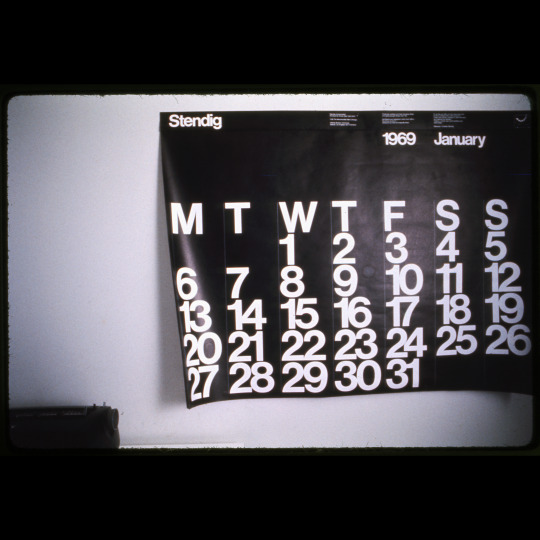
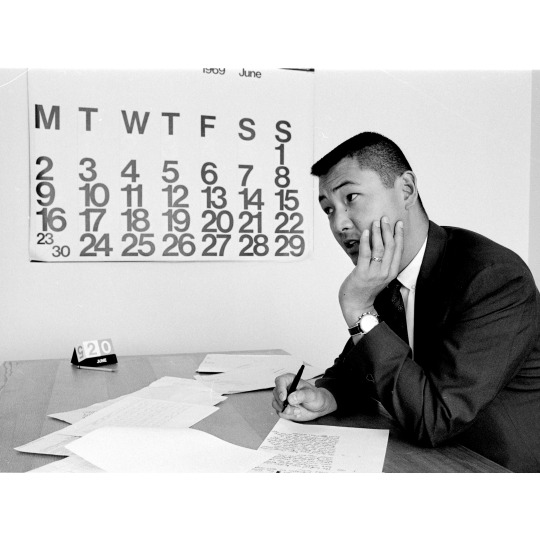

The Stendig calendar has remained a classic for decades! It is not for the faint of heart at 48 inches wide by 36 inches high with bold black and white alternating pages (it even had a brief stint with color page in the 1980s). Designed in 1966 by Massimo Vignelli and has been produced every year since!
“We had always wanted to design a large calendar (3’ x 4’) with big numbers, visible from across a studio floor. Stendig provided us with such an opportunity. We designed the first one toward the end of 1966 and it was distributed in time for Christmas. By the end of December, it was already in the permanent collection of the Museum of Modern Art. Thereafter, Stendig produced it for many years. It has inspired a number of more or less successful imitations.”
Photo descriptions:
1973 unknown photographer, January 1973 in black with white typography
Stan Ries photo shoot c. 1975 which caught Massimo with three Vignelli-designed calendars: Stendig (January 1974), The Max 365 (on number 23) and the Wild Places calendar (August 1975).
1986 reshoot of three Vignelli-designed calendars: Stendig (February 1986), The Max 365 (still on number 23) and the Wild Places calendar (August 1975).
January 1969 at Unimark office
June 1969 at Unimark office with unidentified Unimark staff
Wee little Stendig calendar card! Originally 89 cents each, for a pocket version.
32 notes
·
View notes
Photo

Massimo Vignelli / Stendig / Calendar / 1973 https://ift.tt/R1jsn7u Telegram: https://t.me/gdesignbot
43 notes
·
View notes
Text
Seid ein paar tagen träum ich stendig von fir/uns, obs dir wohl auch so geht, ob das vlt was bedeutet ...
2 notes
·
View notes
Photo
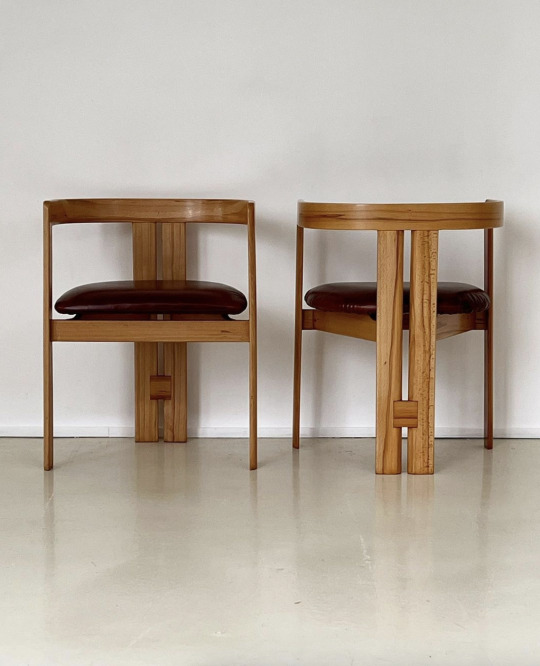
homeunion
1959 beechwood vintage Pigreco chair with leather seats by Tobia Scarpa, imported by Stendig. 🔥
15 notes
·
View notes
Text
Firstest,,marocco so eine armes land der soviso kaum wasser bit hat,20 cent pro gram,,,und hier aus der apoteke 15€ wasser aus reines flussiges goold wasser anschanlich, wasser ist im deuces wasser genug hat fil davon aber is wert voller,,,dan komt dan die deuchland herde und lischt dazzu das kostet alles, Das ist ne eu Bundestag cannabis Schweinerei verhordnung, oder sauerei,,,Alein deuche Luft is nicht gerad gunstig und schtrenge kontrolle ist vorsetzliche garanty,,institutionele inconpetenz und gleich guldikeit is zunehmend in fasst alle,Mich algemein kan wegen mein gesudeitliche zustand nur sagen das der teil legalisirung auf ieden fall ,das man kein hängst mer vor vervollständigen mer haben braucht wegen briccoli,man lebt nicht mer mid der hangst dafur verfolgt zu verden,is schon mal positiv, und das ich endlichgeselschaft fehiger werde und kan mich mer an die menchen ein lassen one trunte negativer Nachfolge zu erzielen,,,macht mich entlich klar in allem,selpst in meinen Geschirr schpulen ,,ken kein Medikamente der die selbe positive Eigenschaften und vortrile als das cannabis medicin ,dafur gipt es kein ersatz tabletten der fur das Wohlbefinden der mench bestimt ist,,nn bei der institutionele medicinische cannabis preise kan kaum ein normale mench der von existenz minimum uberlebt,,nicht davon profitieren ,,Daher der rukfurung des harmen kraut in bayer is joite fur die der sich dal leisten konnen,,leider in baier institutionele hilfe is enlich geworden,nur da fur die es bewerben kann,deuchland is das land der hewiges intitutionele go dewordem,,egal hop um famile get oder sonst wichtiges fur der Erhaltung von korper unfersetheit bestet,aber komt nichtz fur alle mid,,Ich klaub deuchland ist Schlamassel land fur eigen arbeit willlige und fur sich denkenden institutionele nichtz tuher und faulenzer geworde ,der man stendig an hintern zwiken mus danid si in Bewegung bleibenn,aber wen sie sich bewegen immer in der gegengesezte Richtung nach gehen,der das eigene Existenz schetzen und pflegen aber von andaren nicht war nemmen und simid zestoren,die massen von menchen sind an ein par der hartige wesenheiten angewisen,der die fùrsorgen der geringen lebens Unterhalt bevolkerung auskommen mussen , zwangsweise ubernemmen und keine andare weise der existenz interlasse der nicht mal mid Paragrafen besenftigen lassen wen sie nicht von sich selpst diktirt werden,,ein Staat der mich so hapservirt hat mid familien und kegel dan mich 16 jhare lange mid falsche gestelte Diagnosen von denen 3 stsdt psikiater der ich ieder einzel widerschprechen durfte,und ignoriert hat, vergisnan der rest seine existenz nicht mer ,,Mitlerweile bin ich das klaube geworden das in landes menchen von stadt falsch diagnosticirt werden und vegraben und somid weis man aoch nicht wie fille falsch eingetragen werden,,daher weis man nicht genau wie fille menchen in landes, falsch eingetragen schon vekraben sind .
https://www.facebook.com/share/p/Z6ZpaKHfq88uDTyj/

0 notes
Link
[ad_1] Charles Stendig, who introduced contemporary and avant-garde European furniture to adventurous Americans in his New York City showroom, died on Feb. 11 at his home in Manhattan. He was 99.His death was announced by R & Company, a furniture gallery in TriBeCa to which Mr. Stendig donated his design library and corporate archives.There was a period, beginning in the 1960s, when the American living room went cheerfully haywire, becoming a showcase for space age and Pop Art design. The future had arrived, and it was plastic and fantastic and brimming with optimism, mirroring the mod revolution in fashion. Mr. Stendig had a hand in much of it, seeking out European manufacturers, including from Finland, in the days when cargo shipping was cheap.Intrepid and gregarious, he was the first and, for a time, the only American importer of the Finnish designer Eero Aarnio’s bubble furniture, like the Ball Chair, a cocoon-like plastic sphere upholstered on the inside and often accessorized with its own telephone. It had a cameo in the 1960s British television series “The Prisoner” as well as in other dystopian classics.On one mission, Mr. Stendig flew to Prague, which was then part of the Soviet Bloc, to persuade Thonet factory executives to resume making the 1920s-era bentwood and cane dining chairs that they had stopped producing during World War II; he wanted to import those as well. The catch was that he had to guarantee the production costs for a year, as he told Marisa Bartolucci, a design writer who profiled him in 2016 for the antiques and modern furniture site 1stDibs, where vintage Stendig pieces now sell for thousands of dollars.The risk was worth it. For a time in the late 1960s, the cane chairs, now avatars of modern design, seemed ubiquitous in certain American households.Mr. Stendig also sold the elegant leather and chrome furniture of Marcel Breuer, the Hungarian-German Bauhaus architect and designer, including his Wassily Chair, named for the painter Wassily Kandinsky.In Italy, he embraced the Radical Design movement led by mischievous Italian designers who poked fun at consumerist culture by making arch and ironic pieces, like the Bocca, otherwise known as the Marilyn sofa, a bright red foam and jersey number in the shape of a pair of lips. Mr. Stendig brought it to his showroom, in Manhattan.The Bocca was designed by the architect Franco Audrito for Studio 65, the design collective he co-founded, and made by Gufram, a company known for playful foam pieces, like an agreeably goofy-looking cactus designed by Guido Drocco and Franco Mello. Mr. Stendig sold that one, too.The Marilyn sofa was an irresistible Pop Art icon, appearing on magazine covers and apparently scooped up by Hugh Hefner for the Playboy Mansion. Yet Mr. Stendig sold only four, as he told Evan Snyderman, a principal of R & Company. Radical chic didn’t come cheap, even back then.Mr. Stendig imported the wormlike Non-Stop Sofa, an undulating leather creation with sections that zipped together, ad infinitum, designed by Eleonore Peduzzi-Riva, an Italian architect; its nine-inch sections cost $155 in 1974 (about $1,000 in today’s currency).Mr. Stendig was bullish on sectionals. In addition to the Non-Stop Sofa, he sold components in stretch velour that fit together in a half circle.Then there was Joe, named for Joe DiMaggio, a love seat in the shape of a giant leather baseball glove, stitching included, with its fat fingers providing back support. When it made its American debut in Mr. Stendig’s showroom in 1970, it was priced at $1,500 (more than $12,000 today) — not an easy sell, as he told The New York Times.Joe — designed by a trio of Italian architects, Jonathan De Pas, Donato D’Urbino and Paolo Lomazzi — was included in a celebrated exhibition of Italian design in 1972 called “The New Domestic Landscape” at the Museum of Modern Art in New York.But Mr. Stendig showed it first.His business was known as “to the trade,” which meant he sold to architects and designers, who would then sell the pieces to their clients. This arrangement led by accident to one of modern design’s most enduring and coveted objects.For a promotional giveaway for Christmas in 1966, Mr. Stendig asked Massimo Vignelli, the Italian designer of New York City’s subway map, among other graphic feats, to design a calendar. At the time, supergraphics — enormous architectural elements of type and shapes — were having a moment. Mr. Vignelli had always wanted to make a huge calendar with numbers you could see from across a studio floor. What he came up with was a simple grid, three feet by four feet, with the letters of the days of the week at the top and the numbers in rows below, all rendered in pure black Helvetica type on a white background and aligned flush left.The calender was a nearly instant design classic, and the Museum of Modern Art acquired it for its permanent collection.“When you think of the tradition of the promotional calendar, of half-naked girls sitting on tractors hung up in gas stations across the country,” Michael Bierut, former vice president of graphic design at Vignelli Associates, said by phone, “what Massimo did was to base the sex appeal of his calendar in how big and beautiful those numbers are. It’s still so fresh. It’s almost joyful.”The calendar is still in production. (Mr. Bierut pointed out that the used sheets make great modernist wrapping paper.)Suzanne Slesin, a former design reporter for The Times and now editorial director of Pointed Leaf Press, which publishes design and art books, said of Mr. Stendig: “He loved modern furniture, and he was having fun, and it showed. And he was the only one showing this wild and wonderful contemporary furniture. He was it.”Charles William Stendig was born on Oct. 25, 1924, in Brooklyn, the only child of Irving and Rose (Blum) Stendig. His father was an electrician. Charles served as a paratrooper during World War II and then studied business at New York University on the G.I. Bill. He was a traveling salesman of furniture and tableware on the West Coast before going into business for himself in New York.In a bar, over a beer, Mr. Stendig met a Finnish trade representative, who told him that his country’s furniture industry was booming and invited him to come to Finland to have a look.His visit, in a Finnair prop plane, took 26 hours and four refuels, as he told Ms. Bartolucci. The air terminal was a Quonset hut. But when he was taken to Lahti, Finland’s furniture-making capital, Mr. Stendig was gob-smacked by the pristine factories and the work he saw, by designers like Mr. Aarnio, Ilmari Lappalainen and others.The trip inspired him to go into business on his own. With a $300 loan from Paul Secon, a founder of Pottery Barn, which at the time sold slightly flawed ceramic “seconds” from a warehouse in Chelsea, Mr. Stendig opened a showroom in 1956 in a Midtown brownstone. That same year, he married Eleanore Brustein, and they built the enterprise together, opening showrooms in Chicago, San Francisco and Los Angeles.Burlington Industries bought the company in 1971, and the Stendigs stayed on as managers until 1976, when the company was bought again. The couple retired and turned to philanthropy, supporting, among other causes, the UJA-Federation of New York and sponsoring a scholarship program that brought Scandinavian students to study design in the U.S. called “Thanks to Scandinavia.”Ms. Stendig died in 2012. Mr. Stendig leaves no immediate survivors. [ad_2] Source link
0 notes
Text
The 2023 writing Advent calendar: Day 8
8. Gingerbread
“Come on Granny! Why can’t we just eat the dough?” 8-year-old Stella whined and leaned on the counter. “I’m hungry!”
“I can make you a sandwich while we wait,” Monic offered as she raised the pot of gingerbread dough they had made in the morning. It was a special recipe that needed to be refrigerated before the cookies could be baked. “We have some spare salmon lying around.”
“Or… I’m that hungry…” Stella continued. She hated everything to do fish. “But can I at least taske the cookie dough?”
“Okay, one spoon,” Monica nodded, “Only one. Your mother she would have eaten the whole pot if left unsupervised, so I am not taking any chances.”
“I’m not like Mom,” Stella shook her head and started looking for a spoon.
“Sure you aren’t,” Monica smiled.
At that moment the door opened and two Ambar walked in… or well, one Ambar and tiny “Ambar” who was seven years of age.
“Granny Monica!!” Ivory ran to hug Monica.
“Hi there!” Monica hugged Ivory.
“Are they here yet?”
“No, not yet,” Monica responded. “Where is Esme?”
“Did I not tell you that she has a dental appointment? Simon took her.” Ambar sat down on the kitchen table, “Are we eary or is Nina late? That would be the first.”
“Hi! Are we late?” Right on queue, Nina walked through the door.
“No, were not late,” 8-year-old Aurora was looking at her watch, “We were supposed to be here at noon. It’s 11:59:30. 30 seconds early.”
“You’re being specific again,” 7-year-old Laura rolled her eyes as she came behind her. The girls ran toward their friends at once.
“It was okay if I just leave them here right?” Nina asked, “I have mountain I need to get to.”
“Of course it is.” Monica nodded.
“Good, because I have mountain to get to.” Nina nodded back, “Girls, be nice. Dad’s probably the one picking you up so keep your phones on.”
“When are we not nice?”
“Bye Mom!”
“Mountain huh?” Ambar joined Nina on a hallway as she started, “Don’t tell me you have squeezed yourself a deadline before Christmas… Although, I am the one the talk. I came here to get cookies while I answer emails.”
“Mountain as in, Christmas shopping.” Nina clarified. “We got the stuff for the kids weeks ago, but I still have stuff left that I need to get myself, since Gastón took Oscar to that rockclimbing place. You cannot take Aurora shopping or even bring anything to the house while she can see, because then she’ll make her life’s mission to figure out what it is and to who.”
“The pain of having intelligent kids,” Ambar laughed.
“As long as she won’t go work for the police, we’ll be fine.” Nina smiled a bit nervously.
“You said rockclimbing?”
“Yes, Oscar has been clamering to go after he found the place online. And as the school is out, there was no reason why not.”
“You don’t sound like the biggest fan of the idea,” Ambar noted.
“I…” Nina sighed, “I feel like my mother when I just want everyone’s feet stay on the ground. He's ten, ethere nothing actually to be worried about...”
“Well, with what you’ve been through, it’s understandable.”
“It has been 12 years.” Nina ran her hand on her arm, “But it still sometimes gets to me, when someone wants to do something extreme. But I can’t stop Oscar doing something he really wants just because I am afraid, especially since it’s something he and Lucas like to do together. It’s great that they are getting closer, like the girls.”
“Jazmin always says how shopping cleanses the soul,” Ambar joked, “So, you’re going to be okay. And if you need to sue somebody, I’m right here.”
“I am trying not to think that far,” Nina laughed, “See you later.”
“Have fun gift hunting, although hubands are noutoriously hard to shop for.”
After Nina had gone, Ambar walked back into the kitchen, since she really should get to those emails. The girls were stendig in a organized row next to the kitchen counter, waiting for their orer from the maestro herself.
“Okay, girls first we need to roll out the dough so we can cut all the shapes,” Monica instructed while pulling the medal gingerbreadhouse cutters out. She had actually developed her own set as part of the kitchen utensil line for the catering business. “Ivory and Laura can do the roof, while Stella and Aurora the walls.”
“But what about the base?” Aurora asked while seeming like she was measuring the cutter with her fingers, “It needs to be biggest than they house, so the structure has a good basis.”
“Can we decorate the roof tiles with marshmallows?” Laura asked, “So it looks like real slating?”
Ambar smiled to herself. These were daughters of an engineer alright. She turned to her table as te email she had actually needed answering.
“We should put music notes on these?” Ivory piped up, “And add staves and pentagrams.”
Ivory had also come to her father, wondering about music and nothing else…well, music, skating and nothing else. Her choir’s Chrismas recital was coming up and Ambar was looking forward to it immensely.
“Monica, how long will they need to be in the oven?” Aurora looked though the small oven window.
“10 to 12 minutes,” Monica responded, “But we need to keep careful watch over them.”
“I love over watch!” Stella parked herself cross legged in front of the oven.
“Okayyyy,” Aurora seemed to look sceptical, but sat next to Stella on the floor, “How brown do they need to be?”
“I think we have some that you can decorate in the mean time,” Monica pulled and can out a shelf and opened it. The amazing smell of fresh gingerbread filled the kitchen.
“Mom!” Ivory yelled as a protest as Ambar quickly sneaked a cookie from the tin. “You don’t allow me to ever do that!”
“Grown up privileges,” Ambar shrugged as she started typing a email, “Sorry darling. You’re gonna get enough cookies surely. Dad sais yesterday that Grandma just sent some over.”
“What are you doing?” Ivory asked Laura was had been arranging tubes of different colored royal-icing around.
“I wanted lighter pink for the what, so I made some.”
“Cool, can I make yellow?!”
“Yellow’s not a color you can make.”’
“Why not.”
“I don’t know. It just isn’t.”
And here we have our Gastina/Lutte/Simbar girlie besties, because of course we do. I'm juyst gonn say this here, the kids will feature a lot in this calendar so I will always on a new story state how old they are, jst to make things easier. Also, the if the stuff about Nina being worried felt random, it's supposed to. What she actually was afraid of and what happened over ten years ago is intentionally vague... keep your eyes peeled for all my stories during the holiday seasons. You may or may not get answers... but leave quesses in the comments!!
1 note
·
View note
Text

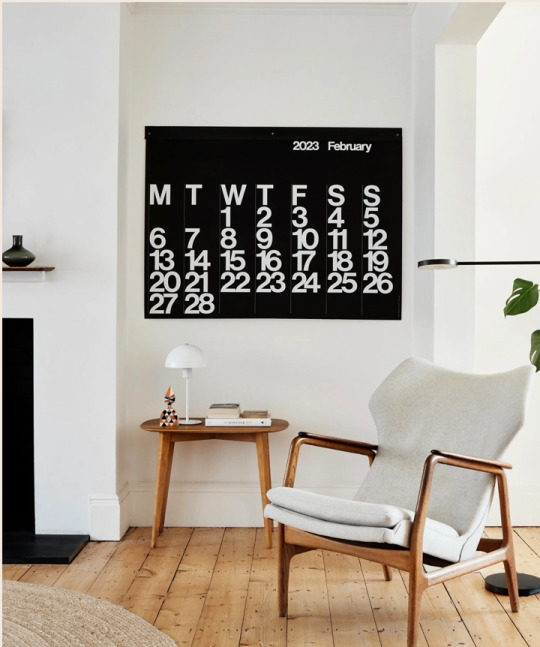
First Iteration of Final Aesthetic
This was the first near-complete version of my brochure. I replaces the grid graphic with a typographic one inspired by the Stendig Calendar by Massimo Vignelli. The Stendig calendar is a textbook use of Helvetica, and I was particularly drawn to the characters close proximity to one another which is echoed in my poster design. I incorporated magenta as a spot colour in order to provide contrast in my designs, drawing attention to specific areas. My goal was to have one side black (poster) and the other white (brochure). I think this works fairly well, but feels a little bare, and I'm not sure that the photo assets are working. Overall though I am happy with the design and think it feels mature and refined.
1 note
·
View note
Photo
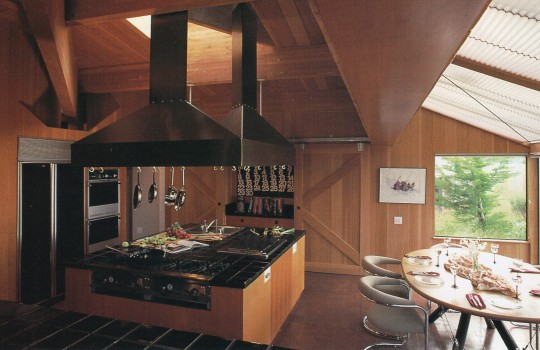
The kitchen is illuminated by a skylight and by the sunlight that streams into the solarium. The owners enjoy dramatic 180-degree views of the meadow and coast as they dine.
The Naturally Elegant Home, 1992
#vintage#vintage interior#1990s#interior design#home decor#kitchen#dining room#black tile#Stendig#solarium#range hood#wood wall#skylight#blinds#ocean view#modern#mid century#style#architecture
620 notes
·
View notes
Text

Using the Stendig Calendar by Massimo Vignelli as wrapping paper is satisfying.
#stendig#Massimo Vignelli#design#gift wrapping#helvetica#typography#graphic design#everyday design#type#figures
10 notes
·
View notes
Photo
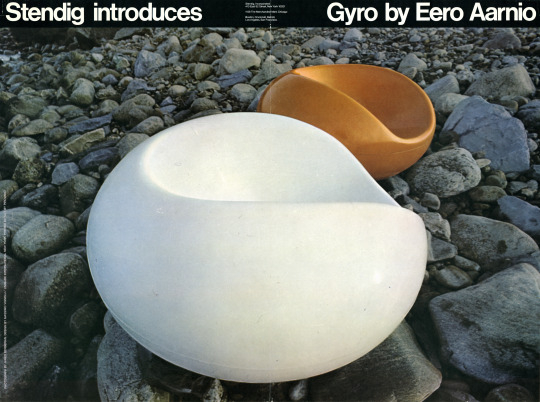
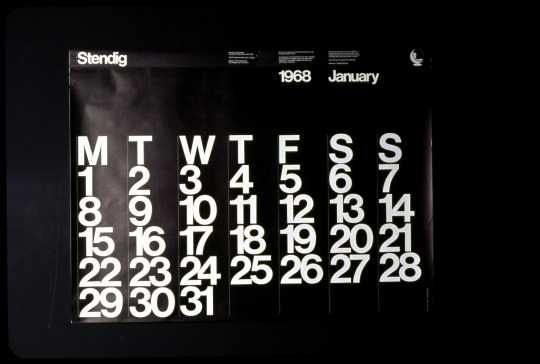
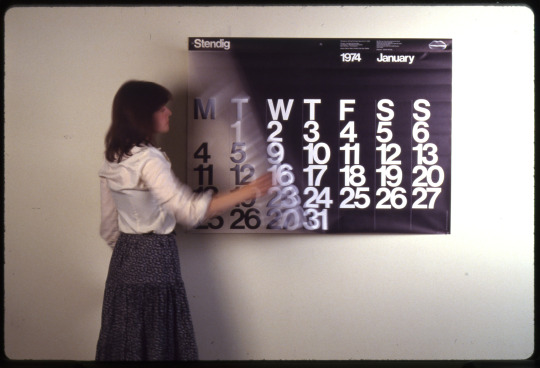
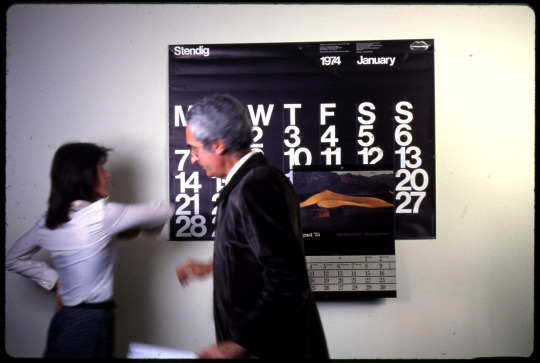
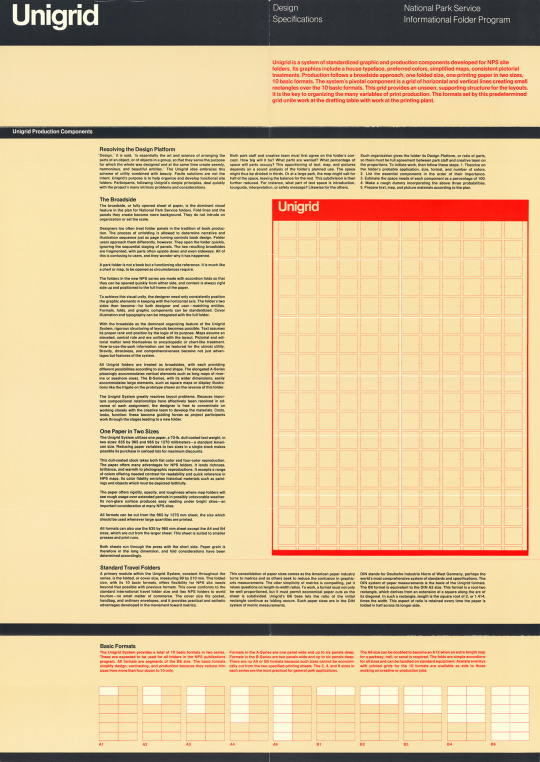


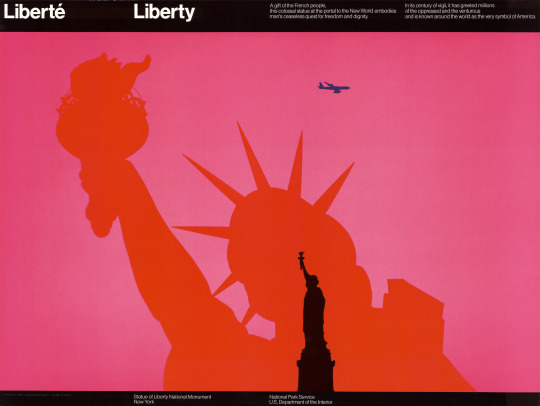
Is it just us or does this Aarnio chair make you want to float down a river under the summer sun? [It really does float!]
Finnish designer Eero Aarnio created the Gyro chair (aka the Pastil or Rock n Roll chair) in 1967. This poster was designed by Massimo Vignelli for Stendig while he worked at the New York Unimark International office circa 1968. The photo was taken by James Berberian.
Does this poster look familiar? That signature black band across the top, with tightly kerned white san serif text, was also on the 1966 Stendig poster-size calendar by Vignelli. This technique also makes an appearance on Vignelli’s Unigrid publications designed in 1976. Both are still in use today.
Keep scrolling to see examples of the Unigrid and the Stendig calendar including Massimo Vignelli caught on camera by photographer Stan Ries during a photoshoot in 1974.
#vignelli#stendig#gyro#posters#design archives#design history#1960s#unigrid#national park service#calendars#so over winter#dreaming of summer#Stan Ries#tight#modernism#aarnio
41 notes
·
View notes
Photo
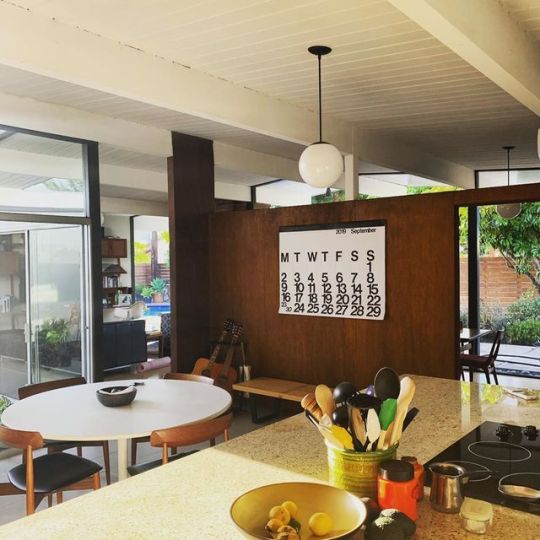
September #stendig #wallcalendar #coastmodern #eichlerhomes #stendigcalendar https://www.instagram.com/p/B1_g6F4pQMv/?igshid=1m9ydps2tegbg
9 notes
·
View notes

